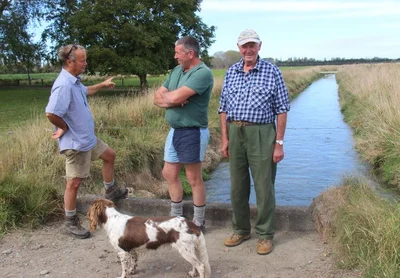ECan backtrack brings creek back to life

Permission from Environment Canterbury to save Greenstreet Creek was too little, too late, landowners say.
Environment Canterbury backtracked over its controversial handling of the Greenstreet Creek on Thursday, allowing the landowners to divert water into the creek.
For Greenstreet farmer Darryl Butterick, the delay in action from ECan was completely unnecessary and costly.
He estimated that 90% of the aquatic life was dead by the time ECan allowed them to restore the flow.
It was a problem of their own creation through enforcing the minimum flows, and it had ignored requests to solve the problem for weeks, Butterick said.
The change of mind won’t undo the reputational damage, he said.
“They have known about it and chose to do nothing.
“It’s only due to media pressure they have made the right decision.
“They have not just got egg on their face, they have the whole chook.”
The landowners first asked for action in mid-February and were earlier this week busy scooping up the dead and dying aquatic life after their requests remained unanswered.
ECan chief executive Dr Stefanie Rixecker then decided to allow water to be diverted into Greenstreet Creek on Thursday.
“I’m making this decision in the face of climate change and in recognition that we didn’t get the “just transition” conversation right. We own that.
“This is not the only place in Canterbury that we will face a challenge like this, but we must work better with our communities and landowners, our rūnanga partners, and the wider public.”
Allowing the diversion is an immediate action but will require further conversations about the future, she said.
O’Sheas Creek flows into the North Branch of the Ashburton/Hakatere River – which is dry so the water wasn’t making it to the river anyway, and the diversion down Greenstreet Creek isn’t impacting the river flows, Butterick said.
“It’s a simple action to keep the creek alive.”
If it was a poisoning of the creek incident caused by the farmer ECan would have acted a lot faster, Butterick said.
The landowners had wanted to take water from the spring-fed O’Sheas Creek to augment the Greenstreet Creek’s flows – which also flows back into the Ashburton River since February.
ECan said no and the solution put forward was to wait for it to rain.
Earlier this week ECan zone delivery manager Jennifer Rochford said all rivers in the Ashburton catchment are currently on full restriction.
“This means consent holders are prohibited from taking water from any waterway in the catchment, regardless of the purpose.
“In the coming months, if sufficient rainfall occurs, we would then expect to see water naturally in the creek.”
That changed on Thursday with Rixecker’s decision.
ECan councillor Ian Mackenzie was critical of the regional council’s handling of the situation.
“It’s a good result but a pity it took so long.
“The regional council is guilty of sitting on their hands and not taking action, but hiding behind the minimum flow plan.
“It is arrogance and it's doing a disservice to the ratepayers of Ashburton.
“The same council is proposing a 24% rate rise of which a large chunk is for biodiversity action and yet here they were taking none.”
The minimum flow restrictions are also part of the problem at Lake Hood, Mackenzie said.
If the lake was able to take some water from the river, like was always intended, it would wash through the lake and return to the river, he said.
“It’s a non-consumptive take that should be allowed and would have likely avoided the algal bloom occurring this summer.”
By Jonathan Leask

